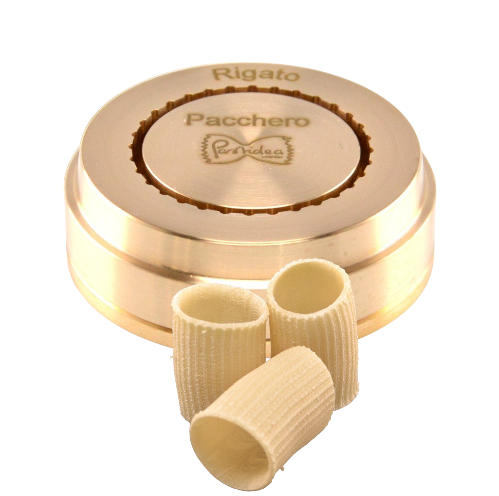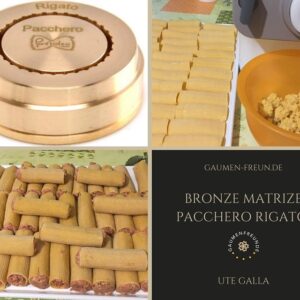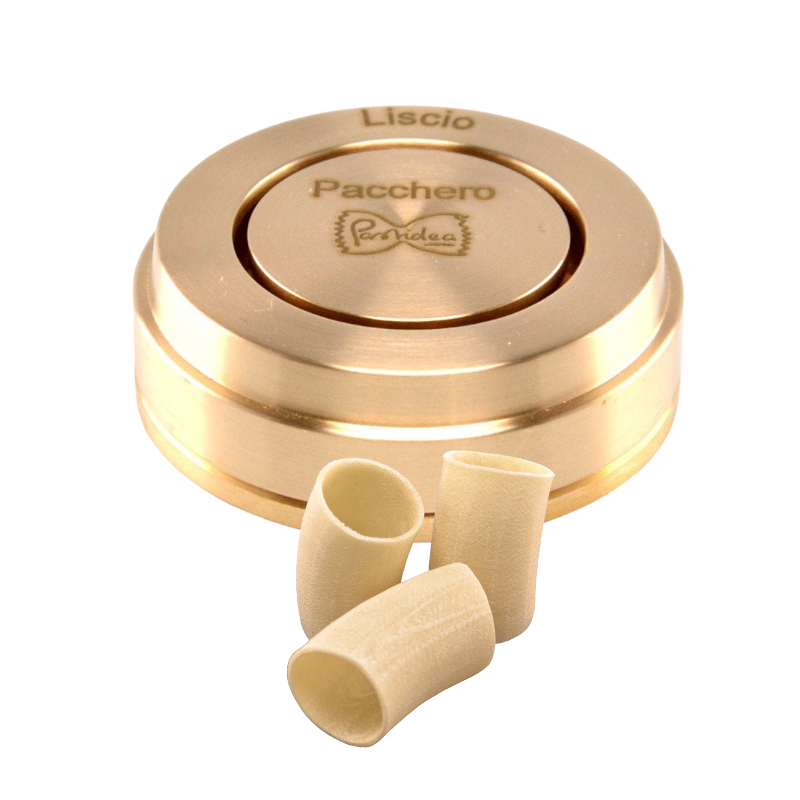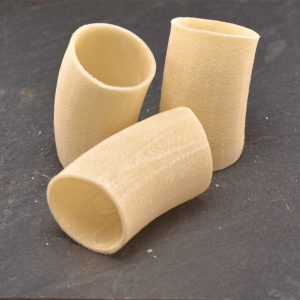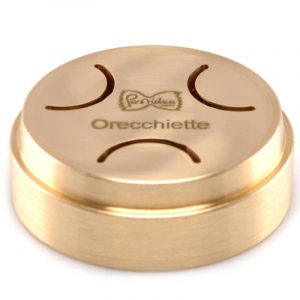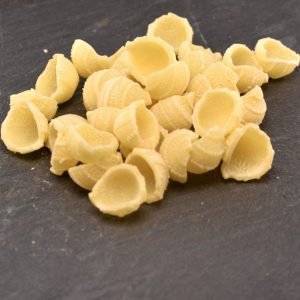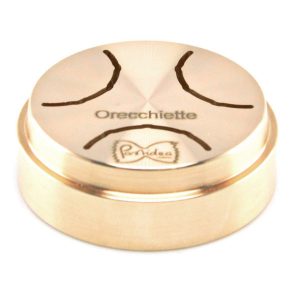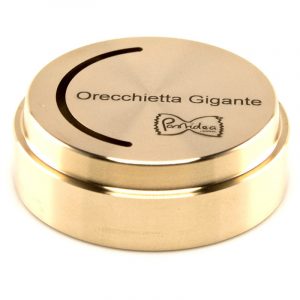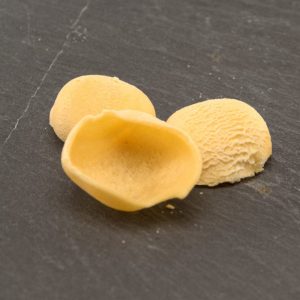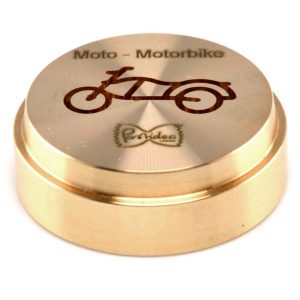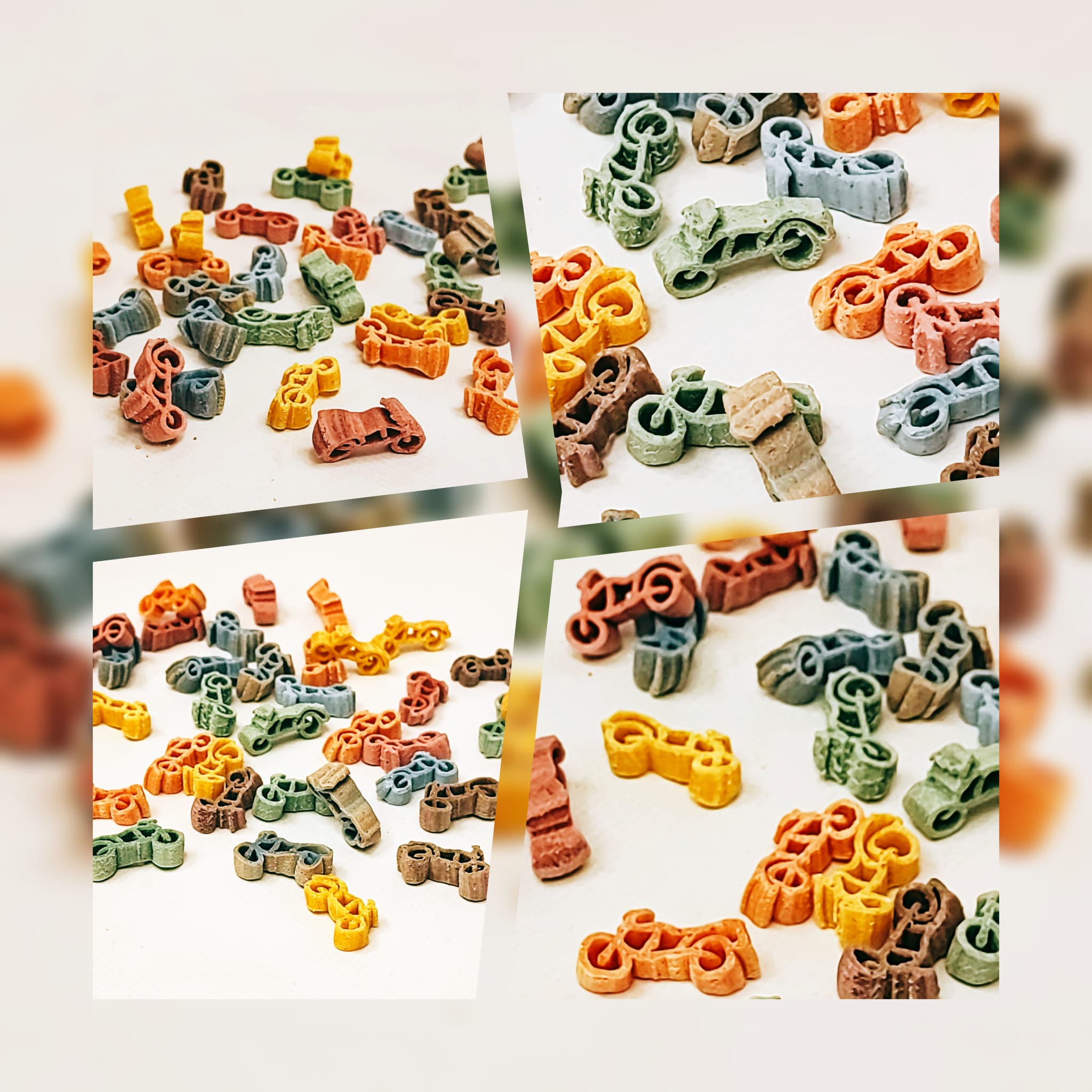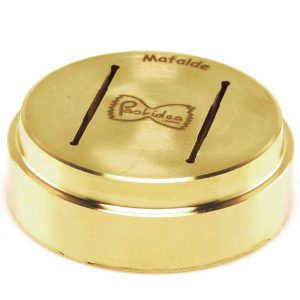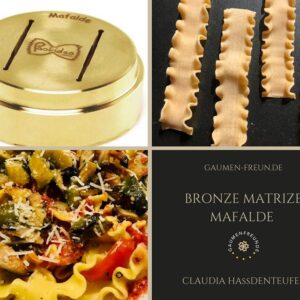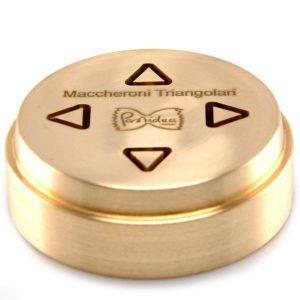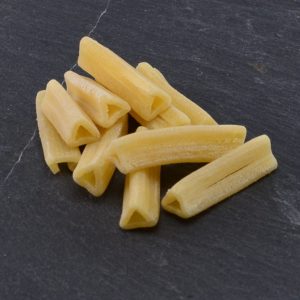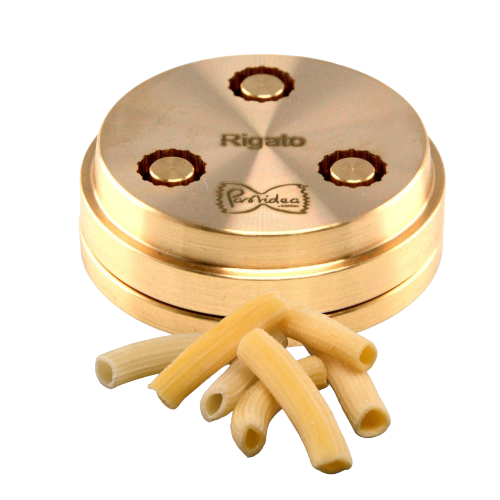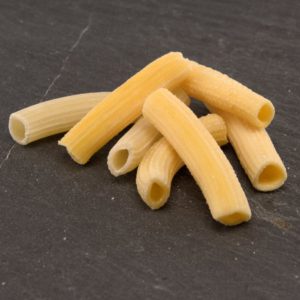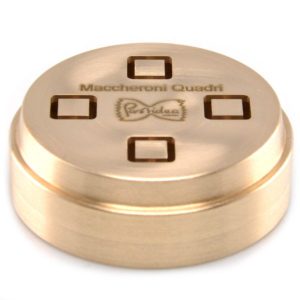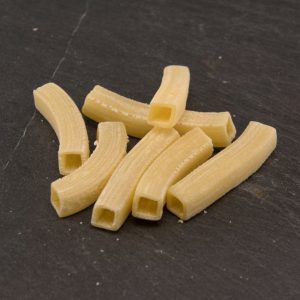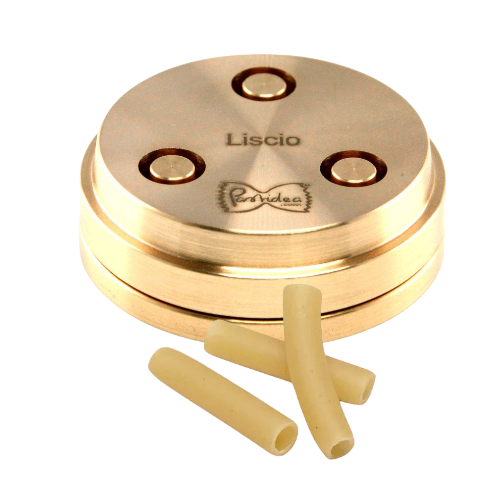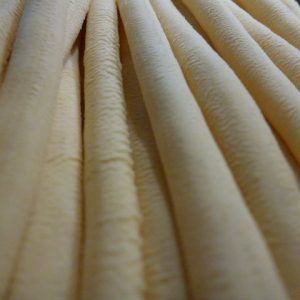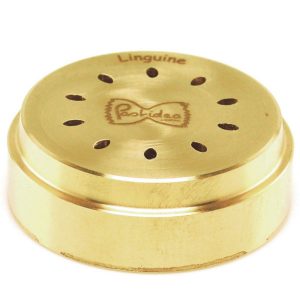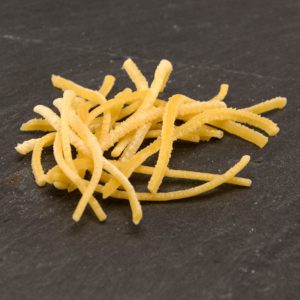35,60 € incl. VAT plus shipping costs
VAT included
excl. Shipping Rate
Pacchero rigato bronze die. Diameter: 25,5mm Thickness: 1,3mm A paccheri is a typical southern Italian pasta. In terms of shape, it is ultimately a gigantic maccheroni, but still a touch smaller in diameter than a cannelloni. This pasta is particularly common in Naples. Paccheri used to be a typical poor man's food. Because they are so incredibly large, you only need a few of them to fill your plate. Paccheri comes in two versions: Rigato (with stripes) and Liscio (smooth). Pasta insert for Kenwood AT910, AX910, KAX910ME, PP510, KAX92.AO, KAX91.A0ME. With an adapter, the die can be used in many other pasta machines, e.g. Philips Pastamaker Avance, Philips Viva, KitchenAid, Simac, Ariete, Unold, La Fattorina, Firmar, TR50, Häussler, Korngold, Omega. The die is delivered together with a transparent transport protection box. Why bronze: Bronze dies were the traditional way of making pasta. The pasta made “al bronzo” can only be found rarely and usually only in selected delicatessens. By pressing the pasta dough through the bronze matrices, the surface of the pasta is slightly roughened at the same time, making the pasta easier to grip. This allows the pasta to better absorb the sauce, flavors and spices later on. Would you like to learn more about bronze matrices? Then we recommend this article to you here. Recipe: It is recommended to use durum wheat semolina, enough cold liquid such as water and/or egg. The dough should be kneaded for about 8-10 minutes, this is the only way the gluten from the durum wheat can fully develop. The result should be a moist, crumbly dough. You can find a standard recipe for our matrices here. The matrices can also be used to produce gluten-free pasta. Sustainability: The format of the pastide matrices was originally designed for the Kenwood Pastafresca. By using reducing rings, the bronze matrices can be used on almost all other common pasta machines. All you need is an adapter that fits the machine. This means that even if over time the pasta machine is replaced by a different model due to a defect or for other reasons: the bronze die remains and can continue to be used in the future. Storage: Do you have several bronze matrices and are you looking for storage to protect the matrix from dust and darkening due to the effects of light? Then we recommend our storage systems, which you can also find in our range. Please note: Please note that the matrices may have small dark spots due to the material and production. This is due to the material and does not affect the function in any way. The matrices are not dishwasher safe. Should be dried immediately after cleaning to avoid water stains.
35,60 € incl. VAT plus shipping costs
VAT included
excl. Shipping Rate
Pacchero liscio bronze die. A paccheri is a typical southern Italian pasta. In terms of shape, it is ultimately a gigantic maccheroni, but still a touch smaller in diameter than a cannelloni. This pasta is particularly common in Naples. Paccheri used to be a typical poor man's food. Because they are so incredibly large, you only need a few of them to fill your plate. Paccheri comes in two versions: Rigato (with stripes) and Liscio (smooth). Pasta insert for Kenwood AT910, AX910, KAX910ME, PP510, KAX92.AO, KAX91.A0ME. With an adapter, the die can be used in many other pasta machines, e.g. Philips Pastamaker Avance, Philips Viva, KitchenAid, Simac, Ariete, Unold, La Fattorina, Firmar, TR50, Häussler, Korngold, Omega. The die is delivered together with a transparent transport protection box. Why bronze: Bronze dies were the traditional way of making pasta. The pasta made “al bronzo” can only be found rarely and usually only in selected delicatessens. By pressing the pasta dough through the bronze matrices, the surface of the pasta is slightly roughened at the same time, making the pasta easier to grip. This allows the pasta to better absorb the sauce, flavors and spices later on. Would you like to learn more about bronze matrices? Then we recommend this article to you here. Recipe: It is recommended to use durum wheat semolina, enough cold liquid such as water and/or egg. The dough should be kneaded for about 8-10 minutes, this is the only way the gluten from the durum wheat can fully develop. The result should be a moist, crumbly dough. You can find a standard recipe for our matrices here. The matrices can also be used to produce gluten-free pasta. Sustainability: The format of the pastide matrices was originally designed for the Kenwood Pastafresca. By using reducing rings, the bronze matrices can be used on almost all other common pasta machines. All you need is an adapter that fits the machine. This means that even if over time the pasta machine is replaced by a different model due to a defect or for other reasons: the bronze die remains and can continue to be used in the future. Storage: Do you have several bronze matrices and are you looking for storage to protect the matrix from dust and darkening due to the effects of light? Then we recommend our storage systems, which you can also find in our range. Please note: Please note that the matrices may have small dark spots due to the material and production. This is due to the material and does not affect the function in any way. The matrices are not dishwasher safe. Should be dried immediately after cleaning to avoid water stains.
32,90 € incl. VAT plus shipping costs
VAT included
excl. Shipping Rate
Bronze Orecchiette die (small size). Orecchiette means something like “little ears” in German – they originally come from the Apulia region with the capital Bari. Traditionally they are made by hand, using a large wooden board, a knife and your fingers. You form a thin roll out of a piece of dough and cut off individual portions, then pull and push them forward at the same time with the handle of a kitchen knife and turn them into small mini ears. In our version, the orecchiette are formed by machine, the shape is slightly different than the hand version, but it is much faster and more relaxed. Pasta insert for Kenwood AT910, AX910, KAX910ME, PP510, KAX92.AO, KAX91.A0ME. With an adapter, the die can be used in many other pasta machines, e.g. Philips Pastamaker Avance, Philips Viva, KitchenAid, Simac, Ariete, Unold, La Fattorina, Firmar, TR50, Häussler, Korngold, Omega. The die is delivered together with a transparent transport protection box. Why bronze: Bronze dies were the traditional way of making pasta. The pasta made “al bronzo” can only be found rarely and usually only in selected delicatessens. By pressing the pasta dough through the bronze matrices, the surface of the pasta is slightly roughened at the same time, making the pasta easier to grip. This allows the pasta to better absorb the sauce, flavors and spices later on. Would you like to learn more about bronze matrices? Then we recommend this article to you here. Recipe: It is recommended to use durum wheat semolina, enough cold liquid such as water and/or egg. The dough should be kneaded for about 8-10 minutes, this is the only way the gluten from the durum wheat can fully develop. The result should be a moist, crumbly dough. You can find a standard recipe for our matrices here. The matrices can also be used to produce gluten-free pasta. Sustainability: The format of the pastide matrices was originally designed for the Kenwood Pastafresca. By using reducing rings, the bronze matrices can be used on almost all other common pasta machines. All you need is an adapter that fits the machine. This means that even if over time the pasta machine is replaced by a different model due to a defect or for other reasons: the bronze die remains and can continue to be used in the future. Storage: Do you have several bronze matrices and are you looking for storage to protect the matrix from dust and darkening due to the effects of light? Then we recommend our storage systems, which you can also find in our range. Please note: Please note that the matrices may have small dark spots due to the material and production. This is due to the material and does not affect the function in any way. The matrices are not dishwasher safe. Should be dried immediately after cleaning to avoid water stains.
32,90 € incl. VAT plus shipping costs
VAT included
excl. Shipping Rate
Medium size bronze orecchiette die. Orecchiette means something like “little ears” in German. They originally come from the Apulia region with the capital Bari. Traditionally they are made by hand, using a large wooden board, a knife and your fingers. You form a thin roll out of a piece of dough and cut off individual portions, then pull and push them forward at the same time with the handle of a kitchen knife and turn them into small mini ears. In our version, the orecchiette are formed by machine, the shape is slightly different than the hand version, but it is much faster and more relaxed. Pasta insert for Kenwood AT910, AX910, KAX910ME, PP510, KAX92.AO, KAX91.A0ME. With an adapter, the die can be used in many other pasta machines, e.g. Philips Pastamaker Avance, Philips Viva, KitchenAid, Simac, Ariete, Unold, La Fattorina, Firmar, TR50, Häussler, Korngold, Omega. The die is delivered together with a transparent transport protection box. Why bronze: Bronze dies were the traditional way of making pasta. The pasta made “al bronzo” can only be found rarely and usually only in selected delicatessens. By pressing the pasta dough through the bronze matrices, the surface of the pasta is slightly roughened at the same time, making the pasta easier to grip. This allows the pasta to better absorb the sauce, flavors and spices later on. Would you like to learn more about bronze matrices? Then we recommend this article to you here. Recipe: It is recommended to use durum wheat semolina, enough cold liquid such as water and/or egg. The dough should be kneaded for about 8-10 minutes, this is the only way the gluten from the durum wheat can fully develop. The result should be a moist, crumbly dough. You can find a standard recipe for our matrices here. The matrices can also be used to produce gluten-free pasta. Sustainability: The format of the pastide matrices was originally designed for the Kenwood Pastafresca. By using reducing rings, the bronze matrices can be used on almost all other common pasta machines. All you need is an adapter that fits the machine. This means that even if over time the pasta machine is replaced by a different model due to a defect or for other reasons: the bronze die remains and can continue to be used in the future. Storage: Do you have several bronze matrices and are you looking for storage to protect the matrix from dust and darkening due to the effects of light? Then we recommend our storage systems, which you can also find in our range. Please note: Please note that the matrices may have small dark spots due to the material and production. This is due to the material and does not affect the function in any way. The matrices are not dishwasher safe. Should be dried immediately after cleaning to avoid water stains.
32,90 € incl. VAT plus shipping costs
VAT included
excl. Shipping Rate
Bronze die Orecchietta gigante. Orecchiette means something like “little ears” in German – they originally come from the Apulia region with the capital Bari. Here we have the “gigante” variant - meaning the little ears are quite big :-). Traditionally, orecchiette are made by hand, using a large wooden board, a knife and your fingers. You form a thin roll out of a piece of dough and cut off individual portions, then pull and push them forward at the same time with the handle of a kitchen knife and turn them into small mini ears. In our version, the orecchiette are formed by machine, the shape is slightly different than the hand version, but it is much faster and more relaxed. Pasta insert for Kenwood AT910, AX910, KAX910ME, PP510, KAX92.AO, KAX91.A0ME. With an adapter, the die can be used in many other pasta machines, e.g. Philips Pastamaker Avance, Philips Viva, KitchenAid, Simac, Ariete, Unold, La Fattorina, Firmar, TR50, Häussler, Korngold, Omega. The die is delivered together with a transparent transport protection box. Why bronze: Bronze dies were the traditional way of making pasta. The pasta made “al bronzo” can only be found rarely and usually only in selected delicatessens. By pressing the pasta dough through the bronze matrices, the surface of the pasta is slightly roughened at the same time, making the pasta easier to grip. This allows the pasta to better absorb the sauce, flavors and spices later on. Would you like to learn more about bronze matrices? Then we recommend this article to you here. Recipe: It is recommended to use durum wheat semolina, enough cold liquid such as water and/or egg. The dough should be kneaded for about 8-10 minutes, this is the only way the gluten from the durum wheat can fully develop. The result should be a moist, crumbly dough. You can find a standard recipe for our matrices here. The matrices can also be used to produce gluten-free pasta. Sustainability: The format of the pastide matrices was originally designed for the Kenwood Pastafresca. By using reducing rings, the bronze matrices can be used on almost all other common pasta machines. All you need is an adapter that fits the machine. This means that even if over time the pasta machine is replaced by a different model due to a defect or for other reasons: the bronze die remains and can continue to be used in the future. Storage: Do you have several bronze matrices and are you looking for storage to protect the matrix from dust and darkening due to the effects of light? Then we recommend our storage systems, which you can also find in our range. Please note: Please note that the matrices may have small dark spots due to the material and production. This is due to the material and does not affect the function in any way. The matrices are not dishwasher safe. Should be dried immediately after cleaning to avoid water stains.
35,60 € incl. VAT plus shipping costs
VAT included
excl. Shipping Rate
Bronze motorcycle die. With an adapter, the die can be used in many other pasta machines, e.g. Philips Pastamaker Avance, Philips Viva, KitchenAid, Simac, Ariete, Unold, La Fattorina, Firmar, TR50, Häussler, Korngold, Omega Why bronze: Bronze matrices were the traditional way of making pasta. The pasta made “al bronzo” can only be found rarely and usually only in selected delicatessens. By pressing the pasta dough through the bronze dies, the surface of the pasta is slightly roughened and the pasta becomes more grippy. This allows the pasta to absorb the sauce, flavors and spices better later Recipe: It is recommended to use durum wheat semolina, sufficiently cold liquid such as water and/or egg. The dough should be kneaded for about 8-10 minutes so that the gluten from the durum wheat can fully develop. The result should be a moist, crumbly dough. We recommend the following standard recipe for our matrices: Ingredients: 250 g durum wheat semolina or Semola rimacinata Select ONE of the following ingredients: 100 ml cold water or 110 ml liquid consisting of two eggs, the rest of the water, lightly whisked Instructions: Please only use cold liquids . Avoid flour, replace it with semolina. Use binding agents such as xanthan gum, gluten, etc. only to a limited extent, a maximum of 1 teaspoon per 500 grams of dry ingredients. Otherwise the dough will be too firm and the dies could break. If you knead the dough for longer or let it rest, the gluten will develop on its own. You can recognize a good pasta dough by the fact that it is moist and crumbly. The production of gluten-free pasta is also possible with the matrices. Sustainability: The format of the Pastidea matrices was originally designed for the Kenwood Pastafresca. By using reducing rings, the bronze matrices can be used on almost all other common pasta machines. All you need is an adapter that fits the machine. This means that even if over time the pasta machine is replaced by a different model due to a defect or for other reasons: the bronze die remains and can continue to be used in the future. Storage: Do you have several bronze matrices and are you looking for storage to protect the matrix from dust and darkening due to the effects of light? Then we recommend our storage systems, which you can also find in our range. Please note: Please note that the matrices may have small dark spots due to the material and production. This is due to the material and does not affect the function in any way. The matrices are not dishwasher safe. Should be dried immediately after cleaning to avoid water stains.
32,90 € incl. VAT plus shipping costs
VAT included
excl. Shipping Rate
Mafalde bronze die, also called Manfredini. Tip: Mafalde and Reginette are very similar pastas. They both have a wavy edge that catches the sauce particularly well. The difference is in the width. The Reginette are 1,8 cm wide. the bronze Mafalde 2,8 cm. Reginette are mainly eaten long. Due to the impressive width of the Mafalde, they also cut a good figure as a side dish. While Reginette translates as "little queen", the Manfredi or Manfredini (who are also known under the name Mafalde) owe their name to a king: They were named after Manfred of Swabia, who was King of Sicily from 1258 to 1266 had his reputation as a sweet tooth. The mafalde were traditionally served with ricotta, the wavy edge helps the ricotta to hold better. Pasta insert for Kenwood AT910, AX910, KAX910ME, PP510, KAX92.AO, KAX91.A0ME. With an adapter, the die can be used in many other pasta machines, e.g. Philips Pastamaker Avance, Philips Viva, KitchenAid, Simac, Ariete, Unold, La Fattorina, Firmar, TR50, Häussler, Korngold, Omega. The die is delivered together with a transparent transport protection box. Why bronze: Bronze dies were the traditional way of making pasta. The pasta made “al bronzo” can only be found rarely and usually only in selected delicatessens. By pressing the pasta dough through the bronze matrices, the surface of the pasta is slightly roughened at the same time, making the pasta easier to grip. This allows the pasta to better absorb the sauce, flavors and spices later on. Would you like to learn more about bronze matrices? Then we recommend this article to you here. Recipe: It is recommended to use durum wheat semolina, enough cold liquid such as water and/or egg. The dough should be kneaded for about 8-10 minutes, this is the only way the gluten from the durum wheat can fully develop. The result should be a moist, crumbly dough. You can find a standard recipe for our matrices here. The matrices can also be used to produce gluten-free pasta. Sustainability: The format of the pastide matrices was originally designed for the Kenwood Pastafresca. By using reducing rings, the bronze matrices can be used on almost all other common pasta machines. All you need is an adapter that fits the machine. This means that even if over time the pasta machine is replaced by a different model due to a defect or for other reasons: the bronze die remains and can continue to be used in the future. Storage: Do you have several bronze matrices and are you looking for storage to protect the matrix from dust and darkening due to the effects of light? Then we recommend our storage systems, which you can also find in our range. Please note: Please note that the matrices may have small dark spots due to the material and production. This is due to the material and does not affect the function in any way. The matrices are not dishwasher safe. Should be dried immediately after cleaning to avoid water stains.
32,90 € incl. VAT plus shipping costs
VAT included
excl. Shipping Rate
Bronze matrix Maccheroni triangolare. Pasta insert for Kenwood AT910, AX910, KAX910ME, PP510, KAX92.AO, KAX91.A0ME. With an adapter, the die can be used in many other pasta machines, e.g. Philips Pastamaker Avance, Philips Viva, KitchenAid, Simac, Ariete, Unold, La Fattorina, Firmar, TR50, Häussler, Korngold, Omega. The die is delivered together with a transparent transport protection box. Why bronze: Bronze dies were the traditional way of making pasta. The pasta made “al bronzo” can only be found rarely and usually only in selected delicatessens. By pressing the pasta dough through the bronze matrices, the surface of the pasta is slightly roughened at the same time, making the pasta easier to grip. This allows the pasta to better absorb the sauce, flavors and spices later on. Would you like to learn more about bronze matrices? Then we recommend this article to you here. Recipe: It is recommended to use durum wheat semolina, enough cold liquid such as water and/or egg. The dough should be kneaded for about 8-10 minutes, this is the only way the gluten from the durum wheat can fully develop. The result should be a moist, crumbly dough. You can find a standard recipe for our matrices here. The matrices can also be used to produce gluten-free pasta. Sustainability: The format of the pastide matrices was originally designed for the Kenwood Pastafresca. By using reducing rings, the bronze matrices can be used on almost all other common pasta machines. All you need is an adapter that fits the machine. This means that even if over time the pasta machine is replaced by a different model due to a defect or for other reasons: the bronze die remains and can continue to be used in the future. Storage: Do you have several bronze matrices and are you looking for storage to protect the matrix from dust and darkening due to the effects of light? Then we recommend our storage systems, which you can also find in our range. Please note: Please note that the matrices may have small dark spots due to the material and production. This is due to the material and does not affect the function in any way. The matrices are not dishwasher safe. Should be dried immediately after cleaning to avoid water stains.
35,60 € incl. VAT plus shipping costs
VAT included
excl. Shipping Rate
Bronze die Maccheroni rigati / Maccheroni with stripes. Maccheroni (in Switzerland they are more commonly known as magronen) are tube pasta that are slightly larger than bucatini and usually a touch smaller than ziti. Depending on the region, they are sometimes eaten whole long or cut short. You have to be careful not to mix them up. Because the pasta that is mostly sold as maccheroni in Germany is a little smaller than this one. This means that anyone looking for German maccheroni will find what they are looking for in a die called “Bucatini”. Pasta insert for Kenwood AT910, AX910, KAX910ME, PP510, KAX92.AO, KAX91.A0ME. With an adapter, the die can be used in many other pasta machines, e.g. Philips Pastamaker Avance, Philips Viva, KitchenAid, Simac, Ariete, Unold, La Fattorina, Firmar, TR50, Häussler, Korngold, Omega. The die is delivered together with a transparent transport protection box. Why bronze: Bronze dies were the traditional way of making pasta. The pasta made “al bronzo” can only be found rarely and usually only in selected delicatessens. By pressing the pasta dough through the bronze matrices, the surface of the pasta is slightly roughened at the same time, making the pasta easier to grip. This allows the pasta to better absorb the sauce, flavors and spices later on. Would you like to learn more about bronze matrices? Then we recommend this article to you here. Recipe: It is recommended to use durum wheat semolina, enough cold liquid such as water and/or egg. The dough should be kneaded for about 8-10 minutes, this is the only way the gluten from the durum wheat can fully develop. The result should be a moist, crumbly dough. You can find a standard recipe for our matrices here. The matrices can also be used to produce gluten-free pasta. Sustainability: The format of the Pastidea matrices was originally designed for the Kenwood Pastafresca. By using reducing rings, the bronze matrices can be used on almost all other common pasta machines. All you need is an adapter that fits the machine. This means that even if over time the pasta machine is replaced by a different model due to a defect or for other reasons: the bronze die remains and can continue to be used in the future. Storage: Do you have several bronze matrices and are you looking for storage to protect the matrix from dust and darkening due to the effects of light? Then we recommend our storage systems, which you can also find in our range. Please note: Please note that the matrices may have small dark spots due to the material and production. This is due to the material and does not affect the function in any way. The matrices are not dishwasher safe. Should be dried immediately after cleaning to avoid water stains.
32,90 € incl. VAT plus shipping costs
VAT included
excl. Shipping Rate
Bronze matrix Maccheroni quadri 7x7 mm / square Maccheroni. Why shouldn't you eat macaroni square instead of round? The shape makes it possible to use it in a variety of ways. Classic as a main course e.g. with a tomato sauce. Or as a side dish to the Sunday roast. Or cut very short - the small cubes look fantastic in a soup. Or as a fried snack with cornmeal, we have that here tried it out. The kids loved it! Pasta insert for Kenwood AT910, AX910, KAX910ME, PP510, KAX92.AO, KAX91.A0ME. With an adapter, the die can be used in many other pasta machines, e.g. Philips Pastamaker Avance, Philips Viva, KitchenAid, Simac, Ariete, Unold, La Fattorina, Firmar, TR50, Häussler, Korngold, Omega. The die is delivered together with a transparent transport protection box. Why bronze: Bronze dies were the traditional way of making pasta. The pasta made “al bronzo” can only be found rarely and usually only in selected delicatessens. By pressing the pasta dough through the bronze matrices, the surface of the pasta is slightly roughened at the same time, making the pasta easier to grip. This allows the pasta to better absorb the sauce, flavors and spices later on. Would you like to learn more about bronze matrices? Then we recommend this article to you here. Recipe: It is recommended to use durum wheat semolina, enough cold liquid such as water and/or egg. The dough should be kneaded for about 8-10 minutes, this is the only way the gluten from the durum wheat can fully develop. The result should be a moist, crumbly dough. You can find a standard recipe for our matrices here. The matrices can also be used to produce gluten-free pasta. Sustainability: The format of the pastide matrices was originally designed for the Kenwood Pastafresca. By using reducing rings, the bronze matrices can be used on almost all other common pasta machines. All you need is an adapter that fits the machine. This means that even if over time the pasta machine is replaced by a different model due to a defect or for other reasons: the bronze die remains and can continue to be used in the future. Storage: Do you have several bronze matrices and are you looking for storage to protect the matrix from dust and darkening due to the effects of light? Then we recommend our storage systems, which you can also find in our range. Please note: Please note that the matrices may have small dark spots due to the material and production. This is due to the material and does not affect the function in any way. The matrices are not dishwasher safe. Should be dried immediately after cleaning to avoid water stains.
35,60 € incl. VAT plus shipping costs
VAT included
excl. Shipping Rate
Bronze die Macherone liscio / Maccheroni smooth / Ziti. Maccheroni (in Switzerland they are more commonly known as magronen) are tube pasta that are slightly larger than bucatini and usually a touch smaller than ziti. Depending on the region, they are sometimes eaten whole long or cut short. You have to be careful not to mix them up. Because the pasta that is mostly sold as maccheroni in Germany is a little smaller than this one. This means that anyone looking for German maccheroni will find what they are looking for in a die called “Bucatini”. Pasta insert for Kenwood AT910, AX910, KAX910ME, PP510, KAX92.AO, KAX91.A0ME. With an adapter, the die can be used in many other pasta machines, e.g. Philips Pastamaker Avance, Philips Viva, KitchenAid, Simac, Ariete, Unold, La Fattorina, Firmar, TR50, Häussler, Korngold, Omega. The die is delivered together with a transparent transport protection box. Why bronze: Bronze dies were the traditional way of making pasta. The pasta made “al bronzo” can only be found rarely and usually only in selected delicatessens. By pressing the pasta dough through the bronze matrices, the surface of the pasta is slightly roughened at the same time, making the pasta easier to grip. This allows the pasta to better absorb the sauce, flavors and spices later on. Would you like to learn more about bronze matrices? Then we recommend this article to you here. Recipe: It is recommended to use durum wheat semolina, enough cold liquid such as water and/or egg. The dough should be kneaded for about 8-10 minutes, this is the only way the gluten from the durum wheat can fully develop. The result should be a moist, crumbly dough. You can find a standard recipe for our matrices here. The matrices can also be used to produce gluten-free pasta. Sustainability: The format of the pastide matrices was originally designed for the Kenwood Pastafresca. By using reducing rings, the bronze matrices can be used on almost all other common pasta machines. All you need is an adapter that fits the machine. This means that even if over time the pasta machine is replaced by a different model due to a defect or for other reasons: the bronze die remains and can continue to be used in the future. Storage: Do you have several bronze matrices and are you looking for storage to protect the matrix from dust and darkening due to the effects of light? Then we recommend our storage systems, which you can also find in our range. Please note: Please note that the matrices may have small dark spots due to the material and production. This is due to the material and does not affect the function in any way. The matrices are not dishwasher safe. Should be dried immediately after cleaning to avoid water stains.
32,90 € incl. VAT plus shipping costs
VAT included
excl. Shipping Rate
Bronze Linguine die 3,2 mm. Linguine comes from the Italian word “lingua”, meaning tongue. Linguine are therefore small tongues. With a little imagination, these noodles, which are similar to spaghetti, are reminiscent of long chameleon tongues. The term "linguine" comes from southern Italy, Campania with the capital Naples. In Liguria (in the north of Italy) this type of pasta is found under the names Trenette or Bavette. There they are mainly eaten with the well-known green Pesto alla Genovese or with mussels. Linguine are usually no wider than 4 mm. Ours from Pastidea are only 3,2 mm wide and therefore particularly delicate. Thanks to the fine milling, they do not fray as easily when pressed as some other linguine made from dies with larger openings. Pasta insert for Kenwood AT910, AX910, KAX910ME, PP510, KAX92.AO, KAX91.A0ME. With an adapter, the die can be used in many other pasta machines, e.g. Philips Pastamaker Avance, Philips Viva, KitchenAid, Simac, Ariete, Unold, La Fattorina, Firmar, TR50, Häussler, Korngold, Omega. The die is delivered together with a transparent transport protection box. Why bronze: Bronze dies were the traditional way of making pasta. The pasta made “al bronzo” can only be found rarely and usually only in selected delicatessens. By pressing the pasta dough through the bronze matrices, the surface of the pasta is slightly roughened at the same time, making the pasta easier to grip. This allows the pasta to better absorb the sauce, flavors and spices later on. Would you like to learn more about bronze matrices? Then we recommend this article to you here. Recipe: It is recommended to use durum wheat semolina, enough cold liquid such as water and/or egg. The dough should be kneaded for about 8-10 minutes, this is the only way the gluten from the durum wheat can fully develop. The result should be a moist, crumbly dough. You can find a standard recipe for our matrices here. The matrices can also be used to produce gluten-free pasta. Sustainability: The format of the Pastidea matrices was originally designed for the Kenwood Pastafresca. By using reducing rings, the bronze matrices can be used on almost all other common pasta machines. All you need is an adapter that fits the machine. This means that even if over time the pasta machine is replaced by a different model due to a defect or for other reasons: the bronze die remains and can continue to be used in the future. Storage: Do you have several bronze matrices and are you looking for storage to protect the matrix from dust and darkening due to the effects of light? Then we recommend our storage systems, which you can also find in our range. Please note: Please note that the matrices may have small dark spots due to the material and production. This is due to the material and does not affect the function in any way. The matrices are not dishwasher safe. Should be dried immediately after cleaning to avoid water stains.


